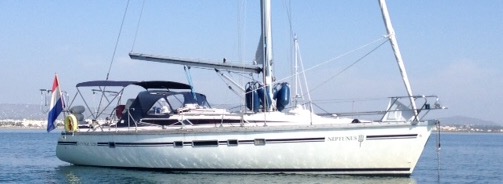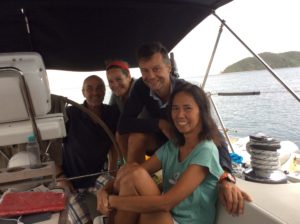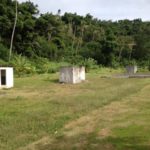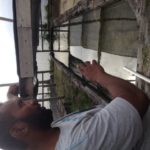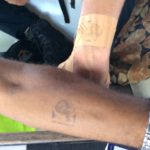It had been very cloudy and cold (25 degrees!) since we left Tonga and when we arrived in SavuSavu, Fiji it was raining. The clouds were so thick and widely spread that there was no sun at all for a few days and it was raining most of the time. Hmmmm….. not really the typical tropical scenes of Fiji that you’d expect. It seems that it rains here more often than in the southerly islands. That’s why everything is so green and lush.
Another Dutch boat “Spunky” who we met in Tonga was also in SavuSavu. But what a really nice surprise was that Olga, the Polish student who was one of our line handlers during the Panama Canal crossing was there too. We haven’t seen her since Panama but kept in touch through email. She sailed from Panama as a crew with an American boat called the “Catalyst”. The “Holandeserrante” arrived a week earlier and have reached their final destination. Since this was the last place we would be together we had a nice farewell dinner with Umberto and his mother before we parted ways. We had a great time sailing with them and hope to see them again in the future.
We must have made a wrong turn and ended up in India because more than half of the people on the streets were Indian. Almost all retail establishments are owned by Indians and when you switch on the radio you hear Indian music. The rest of the population is comprised of Melanesians characterized by their darker color and frizzy hair, Polynesians and Chinese.
The closer we get to the Philippines the more the islands and places we visit look like the ones in the Philippines. It makes me feel right at home because so many things are familiar. What’s funny is that the locals told me they love watching the Filipino movies which are televised daily. Like the Tongans the Fijians are also friendly and always greet you with a smile. One difference we noticed between the two groups is that the Tongans are more reserved and conservative while the Fijians are more extrovert so it’s easier to come in contact with them.
Sevusevu
There is a Fijian tradition called Sevusevu which involves visiting the village Chief and presenting him with a gift of kava roots in a ceremony where he accepts your gift and recites a short speech to welcome you and grant you permission to remain on his property, walk through his village, swim in his sea etc.
Kava comes from the roots of the pepper plant, which are ground to a powder in a pestle and mortar. Then they put the powder in a tea towel, pour water and squeeze it. It is a mildly narcotic drink and has a numbing effect on lips and tongue. The locals call it ‘grog’ and it is widely drunk throughout Fiji and other South Pacific countries. If you are lucky the Chief will invite you to his home to participate in the kava drinking ceremony. I was really looking forward to experiencing this but then we were told that in most places this was done for the tourists. The only place where the authentic Sevusevu is being done is in the southern Lau islands which we were not planning to visit because it was out of our way. But just to make sure we didn’t come empty handed we bought some kava in the local market.
- Kava roots
Typhoon Winston
In February of last year typhoon Winston raced with wind speeds of 280 km/hour through the islands of northern Fiji. There was a lot of devastation and people are still recovering from this disaster. They are rebuilding the houses and buildings but it is a slow process.
We sailed to the small island of Namena where the devastation was clearly visible. There used to be a luxury resort on this island but the whole resort was completely wiped out and now there is only one small house where the caretakers of the island live. The once beautiful reef along the shore is now a cemetery of dead corals and debris. The whole island is a bird sanctuary so there were thousands of birds with their nests perched up on the trees. Because we snorkelled to the shore we didn’t bring our camera so we were not able to take pictures of the birds with their chicks in the nests. The island was also filled with papaya trees and what’s strange was that the caretakers told us that the papaya trees started growing after the typhoon passed.
The next day we sailed to the island of Makogai where we planned to meet Anneke and Robert from the “Spunky” who arrived a day earlier. The journey was a challenge because we had 25 knots of wind against us but when we finally arrived we had a warm welcome from the “Spunky” with some food and drinks on their boat together with another Dutch boat “Let’s go”.
The next day we went ashore to present our gift of kava to the Chief. We asked the man ashore where the Chief was and he said that there was no Chief because the village that used to be there was wiped out by the typhoon. There used to be ten families on the island but after the typhoon many of them went to the main island and so there are now just two families left. Since there was no Chief we decided to present the kava to him instead. He recited a short ceremonial speech in his language and clapped his hands a few times. He then told us that he accepts our gift and was glad that we respected their Sevusevu tradition. He also said that he was thankful that we visited his island because there have not been a lot of visitors since the typhoon last year. He worked for the Ministry of Fisheries and told us that until 1911 there used to be a lepra colony on the island but it is now a place where they grow giant clams for the preservation of the marine life. He then showed us the water basins where they breed the giant clams and explained the process to us.
- This house was prepared for the typhoon
- What’s left of a village after the typhoon
- Water basins giant clams
We stopped at two other islands on our way to Lautoka which was where we were going to clear out. The route to Lautoka was through a passage with beautiful views of the mountains. The scenery here was different from the island of SavuSavu because it drier and sunnier so the mountains were brown and barren.
While we were sailing a large rubber boat with seven uniformed people from Customs and Fisheries approached us and asked if they could come aboard to check our papers. We had to fill in another form and they asked if we had a stamp to stamp the form, which we of course had. They found our stamp to be so cool and asked if they could stamp their arms. 😎
We stayed for two nights at the Vuda Marina. The marina was full and when they showed us our spot we said it was quite small but they managed to literally squeeze us in tightly between two boats like sardines in a can. We really enjoyed the comfort of going ashore without using the dinghy and the luxury of taking “endless” showers at the marina.
Robert and Anneke from the Dutch boat “Spunky” came one day later when they found out we were there. We got together that evening for some drinks and the next day we cleared out at the same time and sailed together to Port Vila, Vanuatu.
